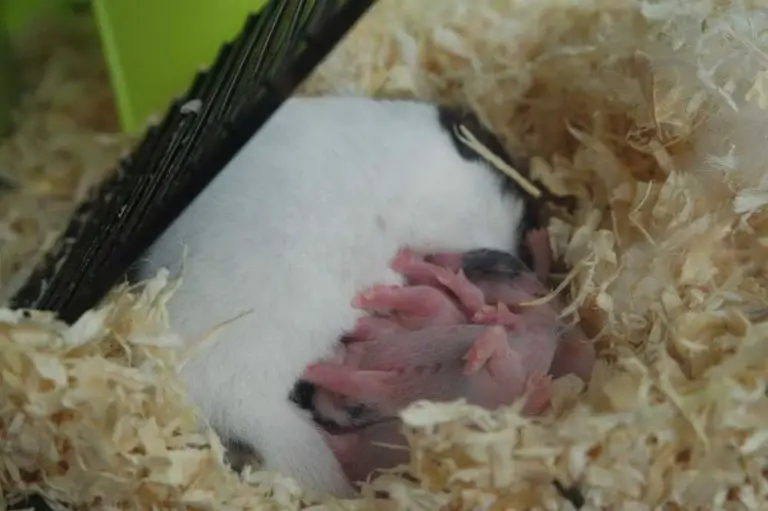Can Hamsters Learn Their Name? (Know The Details)
Yes, hamsters can learn their name. If you talk to your hamster often enough and use their name frequently, they will become accustomed to hearing it and may even learn to come when called. A hamster’s teeth are constantly growing, so they need to gnaw on things to keep them at a manageable length.
How can you teach a hamster to learn its name?
One way to teach a hamster to learn its name is by holding out your hand with a treat in it, then calling the hamster’s name. Say the name slowly and clearly.
If the hamster does not immediately come over, call its name again and reposition your hand so that the treat is more visible. As the hamster approaches, repeat its name using the same inflection.
What are some benefits of a hamster learning its name?
There are many benefits to a hamster learning its name. For one, it can make training and bonding with your hamster much easier.
If your hamster knows its name, you can simply call its name when you want it to come to you, or when you want it to perform a certain behavior. This can be especially useful if your hamster is particularly shy or skittish, as they may be more likely to respond to their name than to other forms of communication.
Another benefit of a hamster knowing its name is that it can help reduce stress for both the hamster and the owner. If your hamster knows that it is safe and loved when it hears its name being called, this can help reduce any anxiety or fear that it may feel in other situations.
How long does it take for a hamster to learn their name?
You may be wondering how long it will take for your new hamster to learn its name. The answer may surprise you – with a little patience and consistency, most hamsters will learn their names in just a week or two!
Here’s what to do:
1. Hold an empty hand out towards your hamster and call its name. If it comes immediately, great! If not, try calling its name two or three more times.
2. If your hamster still does not come, gently gather it up and place it back in its cage. Try again the next day with a treat in hand (more on this below).
3. Repeat steps 1-2 until your hamster consistently comes when called by its name. Once this happens, you can start reducing the number of treats given (e.g., every other time instead of every time).
So why does using a treat help? It’s simply because most hamsters love food and they quickly associate their name with getting something yummy! Just make sure you use a healthy treat that is suitable for your hamster’s diet – things like small pieces of fruit or vegetables work well.
What are some signs that a hamster is beginning to learn its name?
There are a few key signs that your hamster is beginning to learn its name. One of the most common indications is if your hamster starts coming to you when you call its name.
This means that it has associated the sound of its name with your presence, and knows that you’re likely to provide food or attention. Another sign is if your hamster begins responding to commands that you give it using its name.
For example, if you’ve been teaching your hamster to come when called, and it starts doing so consistently, this is a good sign that it has learned its name.
Additionally, if your hamster begins making specific vocalizations when it hears its name, this can be another indication that it is recognizing the sound as being associated with itself.
What are some things you should do to help a hamster learn its name?
If you want to help your hamster learn its name, there are a few things you can do. First, hold out your hand with a treat in it and call your hamster’s name. Say its name slowly and clearly. If your hamster does not immediately come over, call its name again and reposition your hand so that the treat is more visible. Then, as your hamster approaches, repeat its name using the same inflection.
Another thing you can do to help your hamster learn its name is to use positive reinforcement when it responds to its name. For example, if you call your hamster’s name and it comes over to you, give it a tasty treat or praise it verbally. This will let the hamster know that coming when called is a good thing!
Finally, be consistent in how you say the hamster’s name and in what actions you take when calling it. If you always call the hamster by its full name ( “Fluffy” ) but sometimes give it a treat when calling and other times scold it for getting into mischief, the poor little creature will get confused! So try to keep things consistent – use the same tone of voice and offer the same type of reward (or lack thereof) each time you say its name.
What are some things you should avoid doing when trying to help a hamster learn its name?
When you’re trying to help your hamster learn its name, there are a few things you should avoid doing. First, don’t try to teach your hamster its name all at once. spacing out the lessons will help your hamster retain the information better.
Secondly, don’t get frustrated if your hamster doesn’t seem to be progressing as quickly as you’d like; every hamster is different and some will catch on more quickly than others.
Finally, avoid using negative reinforcement when teaching your hamster its name; rewarding your pet for good behavior is much more effective than scolding it for getting it wrong.
What are some common mistakes people make when trying to help a hamster learn its name?
One of the most common mistakes people make when trying to help a hamster learn its name is not being consistent.
When you first start calling your hamster by its name, you need to be consistent with it. This means using the same tone of voice and saying the name, in the same way, every time. If you are inconsistent, your hamster will get confused and will not be able to learn its name.
Another common mistake is not giving the hamster enough time to learn its name. It can take some time for a hamster to learn its name, so you need to be patient and give it plenty of chances to hear its name before expecting it to respond. Finally, another mistake people make is trying to teach their hamsters too many things at once.
When you are first teaching your hamster its name, focus on that and nothing else. Once your hamster knows its name well, then you can start teaching it other things like tricks or commands.
How can you tell if a hamster has successfully learned its name?
There are a few ways to tell if your hamster has learned its name. One way is to see if your hamster responds when you call its name. Another way is to see if your hamster comes to you when you call its name. If your hamster does either of these things, then it has probably learned its name.
Another way to tell if your hamster has learned its name is to give it a treat when you call its name. If your hamster comes over to get the treat, then it has likely learned that its name means there is a reward coming. You can also try this with other things that your hamster likes, such as petting or playtime. If your hamster comes over when you offer these things, then it probably knows its own name.
If you’re not sure whether or not your hamster knows its own name, there’s no harm in trying out different methods and seeing what works best for your pet.
Are there any risks associated with hamsters learning their name?
There are no risks associated with hamsters learning their name. In fact, it can be quite beneficial for them. Hamsters that know their name are more likely to respond to their owner when called and feel more bonded to them.
Additionally, knowing their name can help a hamster feel more secure in their environment since they will recognize the sound of their owner’s voice.
Can hamsters Recognize Other People?
Yes, hamsters can recognize other people. According to Betsy Sikora Siino, hamsters bond with one to two people, which means that your hamster may tolerate guests and other family members, but he’ll only bond and recognize you and possibly one other person. This is because hamsters are social creatures who form bonds with those they interact with regularly.
So, if you’re the primary caretaker of your pet hamster, he will likely recognize you as the source of food and attention, and may even come to enjoy your company. However, it’s important to note that not all hamsters will be equally sociable – some may prefer to stay aloof from humans altogether.
If your hamster does seem fond of you, though, there’s no need to worry about him forgetting your face; studies have shown that these furry little creatures have excellent long-term memory.
How Smart Are Hamsters Compared To Other Rodents?
Hamsters are one of the most popular pets in the world and for good reason. They’re small, cute, and relatively easy to care for. But how smart are they compared to other rodents?
In general, hamsters are not as intelligent as some other types of rodents. For example, rats have been shown to be much more adaptable and trainable than hamsters. However, this does not mean that hamsters are unintelligent. In fact, they are still quite clever creatures.
One area where hamsters excel is in their ability to remember routes and find their way back home. This is likely due to their strong sense of smell. Hamsters have also been known to solve simple puzzles and escape from complex labyrinths – both feats that require a good deal of intelligence.
How well do hamsters learn their name?
Hamsters are intelligent creatures and can learn their name if you talk to them frequently enough. Their teeth are always growing, so they need to gnaw on things to keep them sharp.
How do hamsters learn their name?
Hamsters are intelligent creatures who can even learn their name. If you talk to your hamster and use their name frequently enough to get them used to hearing it, they might even learn to come when called.
Hamsters have excellent memories and can remember things that have happened to them in the past.
When you talk to your hamster and use their name often, they will begin to associate that sound with themselves.
Over time, they will learn that when they hear their name, it means that someone is trying to communicate with them.
What is the best way to teach a hamster their name?
One of the best ways to teach a hamster their name is by holding out a treat in your hand and then calling their name. Say the hamster’s name slowly and clearly, making sure that the treat is visible.
If the hamster does not come over immediately, call its name again and reposition your hand so that the treat is more visible.
As your hamster approaches, repeat its name using the same inflection. This will help them to associate their name with something positive (i.e., a tasty treat!) and they’ll soon learn to respond when you call their name.
Why do some hamsters never learn their name?
Hamsters are small, nocturnal rodents that are popular pets. While they are often thought of as low-maintenance pets, hamsters require regular care and attention. One important aspect of caring for a hamster is providing them with a name.
While most hamsters will eventually learn their name, some never do. There are a few possible reasons why this may be the case. First, it is important to note that hamsters have poor eyesight. This means that they may not be able to recognize their owner by sight, making it more difficult for them to learn their name.
Additionally, hamsters have poor memories and tend to forget things quickly. This means that even if they do hear their name being called, they may not remember it long enough to associate it with themselves. Finally, some experts believe that hamsters simply don’t care about their name and don’t see the need to learn it.
There is no one definitive answer as to why some hamsters never learn their name. However, understanding the limitations of these small creatures can help owners better manage expectations and provide the best possible care for their furry friends.
What happens when a hamster doesn’t learn their name?
When a hamster doesn’t learn their name, they may become anxious or stressed when around humans.
This is because they won’t recognize the sound of their name being called and may think that it’s a cue to run away or hide. Additionally, not learning their name can make it difficult for owners to bond with them.
Is there a difference between male and female hamsters when it comes to learning their name?
It is a common misconception that male and female hamsters differ in their ability to learn their name. However, this is not the case! Both genders of hamsters are equally capable of learning their name and responding to it when called.
There are a few things to keep in mind when teaching your hamster its name. First, be sure to use the same tone and inflection each time you say the name. This will help your furry friend associate the sound with itself.
Second, give your hamster plenty of treats whenever it responds correctly to its name. This positive reinforcement will encourage your pet to continue paying attention when you call its name.
Do hamsters forget their name?
No, hamsters do not forget their name. They are able to remember their name and other basic information about themselves. Hamsters have good memories and can remember things for long periods of time.
What are some common names for hamsters?
Hamsters are one of the most popular pets in the world and their popularity is only increasing.
They are known for being small, cute, and relatively easy to care for, which makes them ideal pets for busy people or those with limited space. While hamsters can make great pets, they do require some care and attention.
One of the first things you need to do when considering a hamster as a pet is to decide what type of hamster you would like.
There are several different types of hamsters available, each with its own unique set of characteristics.
The most common type of hamster is the Syrian hamster, also known as the golden hamster or teddy bear hamster.
Syrian hamsters are typically between 6-8 inches long and weigh around 5-7 ounces. They have thick fur that can be brown, black, cream, gold, or a mixture of these colors. Syrian hamsters are typically very active and playful but can also be shy and timid around new people or animals.
Another type of common hamster is the dwarf Campbell’s Russian Hamster.
Dwarf Campbell’s Russian Hamsters are smaller than Syrian hamsters, typically only 4-6 inches long and 2-4 ounces in weight. They have similar coloring to Syrianhamasters but their fur is often thinner and less dense.
Dwarf Campbell’s Russian Hamsters tend to be more active thanSyrianhamtersand may not be suitable for young children who want a calm pet to cuddle with.
Do hamsters need attention?
Hamsters are small, easy-to-care-for pets that can make great starter animals for children. They don’t require a lot of attention and can get enough exercise running on their wheel.
Hamsters are also cute, cuddly, and pleasant to hold. However, it’s important to note that hamsters don’t come with care instructions. This means that potential owners should do their research before bringing home a hamster.
While hamsters don’t need a lot of attention, they still need some basic care in order to thrive. For example, hamsters need fresh water and food every day. They also need a clean cage with plenty of room to play and explore. Additionally, hamsters should be handled gently and carefully to avoid injury.
Can hamsters learn tricks?
Yes, hamsters can learn tricks. With a little patience and some tasty treats, you can teach your hamster to do all sorts of fun tricks. Some of the most popular hamster tricks include begging, jumping, rolling over, playing dead, and even backflipping!
Teaching your hamster its name is a great way to start bonding with it. You can also begin teaching it simple maze running skills. These are both excellent foundation tricks that will make learning more complex tricks much easier. As your hamster masters these basic skills, you can start rewarding it with out-of-cage time and yummy snacks like seeds, nuts, fresh fruits, and vegetables.
New tricks are always a great way to spice up your playtime together. Not only are they fun for both you and your hamster, but they’re also an excellent form of exercise.
Do hamsters like affection?
Yes, hamsters do like affection! They are small, cuddly creatures that love to snuggle up with their owners. While they may not be as expressive as other pets, they still appreciate a good head scratch or belly rub.
Hamsters are social animals by nature and enjoy being around people. In the wild, they live in burrows with other hamsters and interact frequently with one another. This natural inclination towards socialization carries over into their domesticated lives as well.
While some hamsters may be shyer than others, most of them will warm up to their owner after a little time and become quite attached. Hamsters have even been known to form close bonds with their human caretakers, much like other pets such as dogs and cats.







